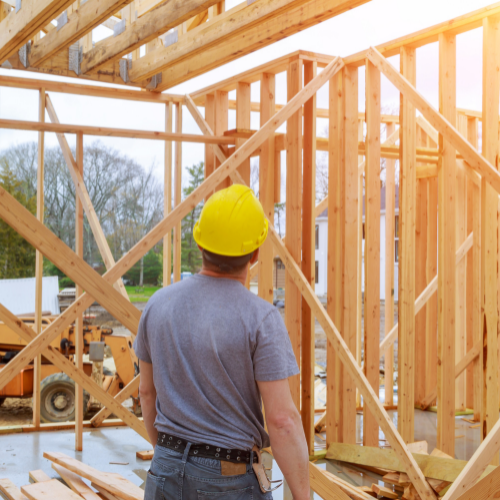In case you missed it see what’s in this section
Let's Talk

New Builds And Self Builds: What You Need To Know
The allure of self-building in the UK has grown exponentially over the years, offering individuals the unique opportunity to craft homes tailored to their specific desires. This trend is not just about constructing a dwelling; it's about realising a dream. As more Britons venture into this realm, it's crucial to grasp the intricacies of the self-build landscape.
From navigating planning permissions to understanding the local housing market dynamics, embarking on a self-build journey requires thorough research and preparation. With the right knowledge and resources, potential homeowners can transform their visions into tangible, bespoke living spaces that resonate with their personal aesthetics and functional needs.
Eco-Friendly Building
The emphasis on eco-friendly building has never been more pronounced. As homeowners and builders in the UK become increasingly conscious of their environmental footprint, the role of ecological surveys in the self-build process has gained paramount importance. These surveys serve as a critical tool in assessing the potential impact of a new build on the local ecosystem, ensuring that the construction does not disrupt native flora and fauna or contribute to habitat loss.
Conducting an ecological survey is not merely a tick-box exercise; it's a commitment to sustainable building practices. 24Housing can help you complete your surveys and get the ball rolling on your build quickly. By identifying and understanding the biodiversity of a plot, builders can make informed decisions, from the placement of the structure to the materials used. This proactive approach not only minimises environmental harm but can also enhance the natural beauty of the property, integrating the home seamlessly into its surroundings.
With local councils in the UK placing a heightened focus on sustainability, an ecological survey can be a decisive factor in obtaining planning permissions. For those looking to invest in the future, understanding and prioritising the environment is not just an ethical choice but a practical one, ensuring the longevity and harmony of their self-build projects.
Green Belt Versus Green Field
The UK's land classification system, particularly the distinction between Green Belt and Green Field lands, is a pivotal consideration for potential self-builders. At first glance, these terms might seem interchangeable, but understanding their nuances can be the difference between a smooth building process and unexpected roadblocks.
Green Belt land refers to areas specifically designated to curb urban sprawl, preserving the character of historic towns and preventing neighbouring towns from merging. These areas act as the "lungs" of urban regions, providing green spaces for recreation and habitat for wildlife. Building on Green Belt land is heavily restricted, with planning permissions often challenging to obtain.
On the other hand, Green Field sites are undeveloped lands, typically associated with agricultural use. While they haven't been previously built on, they aren't necessarily protected like Green Belt areas. Local authorities have the discretion to grant planning permissions on these sites, especially when there's a shortage of development land.
For self-builders, it's essential to recognise these distinctions early on. While building on a Green Field site might be more straightforward, Green Belt lands come with their own set of challenges and opportunities. Thorough research and consultation with local planning departments can pave the way for informed decisions, ensuring that the chosen plot aligns with the project's vision and feasibility.
Size Matters
The age-old adage "bigger is better" doesn't always hold true. While sprawling estates and expansive interiors might seem enticing, the key to a successful self-build often lies in striking the right balance between size and functionality. A well-designed, modest-sized home can offer more comfort, efficiency, and aesthetic appeal than a larger, less thought-out space.
One of the primary considerations is the plot itself. Overextending by trying to fit a massive structure on a limited plot can lead to a cramped environment, both inside the house and in the surrounding outdoor spaces. Such an imbalance can also detract from the property's visual appeal and its harmony with the neighbourhood.
Inside the home, vast open-plan areas might seem luxurious, but they come with challenges. Larger spaces can be harder to heat efficiently, leading to increased energy costs. Acoustically, they can amplify noise, making the environment less serene. Moreover, the charm of having multiple rooms or bathrooms can quickly fade when considering maintenance and cleaning.
For many, the essence of a home lies in its cosiness, its ability to cater to the inhabitants' needs, and its reflection of their personality. By prioritising thoughtful design over sheer size, self-builders can create spaces that truly feel like home.
The True Cost Of Self-Building
A self-build journey is an exciting venture, but understanding the financial implications is paramount. While the allure of crafting a bespoke home tailored to individual preferences is undeniable, it's essential to be well-informed about the costs involved. On average, building a home in the UK costs between £1,800 and £3,000 per square metre. Given that the typical UK property, a three-bedroom house, measures around 800sq ft or 74sq metres, a self-build project could set you back anywhere from £133,000 to £222,000.
But that's not all; additional expenses come into play. It's prudent to allocate an extra 15% for professionals like engineers and architects. Moreover, a contingency budget of 10% is advisable to cover unforeseen costs that inevitably arise during construction. Planning applications, legal fees, demolition, and self-build insurance are other factors to consider. For instance, a planning application might cost
£334 if approved immediately but can escalate if complications arise. Ultimately, while self-building can offer cost advantages in certain scenarios, it's crucial to approach the process with a comprehensive understanding of the potential expenses to ensure a smooth and successful project.
The self-build journey in the UK is both an exciting and intricate endeavour. From understanding the nuances of land classifications and ecological considerations to navigating the financial landscape, it's a path laden with decisions. While the allure of crafting a bespoke home is undeniable, success lies in thorough research, meticulous planning, and striking the right balance between design and functionality.
By prioritising sustainability, cost-efficiency, and thoughtful design, potential homeowners can transform their visions into tangible living spaces that resonate with their aspirations, ensuring a harmonious blend of personal aesthetics and practicality.
Weather in Bath
Listings

















